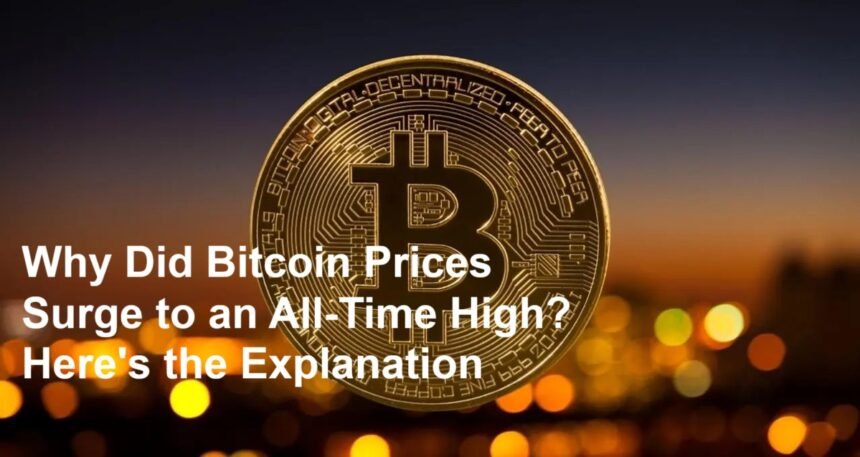Introduction
In recent months, Bitcoin has experienced a dramatic increase in its price, reaching levels not seen in several years. This surge has captured the attention of investors, traders, and the general public alike. Many are wondering: what are the primary reasons behind Bitcoin’s meteoric rise? In this article, we’ll explore the key factors fueling this rally and what it could mean for the future of cryptocurrencies.
1. Institutional Adoption and Institutional Investment
One of the most significant drivers of Bitcoin’s recent price surge is the increasing participation of institutional investors. Major financial firms, hedge funds, and publicly traded companies have started to recognize Bitcoin as a legitimate asset class. Notable corporations like Tesla, MicroStrategy, and Square have added Bitcoin to their balance sheets, signaling confidence in its long-term value.
The entry of institutional players brings substantial capital and credibility to the market. Their involvement has helped to stabilize Bitcoin’s price and reduce volatility. Additionally, institutional investment products, such as Bitcoin futures and exchange-traded funds (ETFs), have made it easier for large investors to gain exposure. This influx of institutional money has been a major catalyst for the recent bullish momentum.
2. Economic Uncertainty and Inflation Hedge
The global economy has been grappling with unprecedented challenges, including inflationary pressures driven by expansive monetary policy and government stimulus packages. Central banks, especially the U.S. Federal Reserve, have maintained low interest rates and engaged in quantitative easing to support economic recovery.
Many investors view Bitcoin as a hedge against rising inflation and currency devaluation, similar to gold. As fiat currencies weaken due to inflation, more people turn to Bitcoin as a store of value. This perception has increased demand, pushing the price upward. In uncertain economic times, Bitcoin’s limited supply and decentralized nature make it attractive as a safe haven asset.
3. Retail Investor FOMO (Fear of Missing Out)
The proliferation of accessible crypto trading platforms and social media has fostered a wave of retail investor participation. News of Bitcoin’s surges often triggers a classic FOMO effect, where retail investors rush to buy in, hoping to profit from further increases.
This surge of retail interest amplifies buying pressure, contributing to rapid price rises. Memes, online communities, and influencers have played a role in spreading awareness and enthusiasm around Bitcoin, fueling the speculative frenzy. In recent months, retail investors have been a significant component of the buying volume, amplifying the upward trend.
4. Technical Breakthroughs and Market Sentiment
Technical analysis also supports the recent rally. Bitcoin recently broke through key resistance levels, which traders interpret as bullish signals. This break can trigger buy signals for technical traders, further boosting demand.
Market sentiment has shifted positively, with many analysts and market commentators signaling bullish outlooks. Positive news, such as regulatory clarifications, endorsements from influential figures, or large transactions, also reinforce investor confidence. As sentiment turns bullish, more investors tend to jump on the bandwagon, driving the price even higher.
5. Regulatory Clarifications and Favorable Developments
Although regulation remains a concern, recent developments have provided clarity and reassurance to some investors. In several countries, regulators are working to create clearer frameworks for cryptocurrencies, which enhances legitimacy.
Historically, government crackdowns or bans have caused sharp declines, but the current trend shows increasing acceptance and integration into mainstream finance. Some countries have announced plans to legalize or regulate Bitcoin, which reduces uncertainty and encourages investment. These favorable outlooks help stabilize and even boost Bitcoin’s price.
6. Limited Supply and Halving Cycles
Lastly, Bitcoin’s core protocol enforces a fixed supply cap of 21 million coins. The recent halving event—where the reward for miners is cut in half—reduces new Bitcoin supply entering the market. Historically, halving events have been followed by substantial price increases, as supply growth diminishes while demand often rises.
The latest halving occurred in 2020, and its effects have played out over time, contributing to a supply squeeze that has supported higher prices. Investors anticipate that this supply scarcity will continue to push prices upward in the long term.
Conclusion
Bitcoin’s recent surge is driven by a confluence of factors: increasing institutional adoption, economic uncertainties prompting a search for safe havens, retail investor enthusiasm, technical breakthroughs, regulatory clarity, and supply constraints due to halving. While the cryptocurrency market remains volatile and unpredictable, these fundamental drivers have contributed to Bitcoin’s climb to new heights.
As the market evolves, it’s essential for investors to stay informed and cautious. Bitcoin’s high volatility presents both significant opportunities and risks. Nevertheless, the current bullish momentum suggests that Bitcoin continues to solidify its position as a major asset in the global financial landscape.












